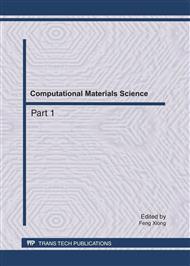[1]
P. Havig, S. Grigsby, E. Heft, J. Lacreta, and D. Post, Luminance contrast and color recognition in helmet-mounted displays, in SPIE proceedings series, 2001, p.198–204.
DOI: 10.1117/12.437995
Google Scholar
[2]
E. Peli, Optometric and perceptual issues with head-mounted displays. McGrawHill, New York, p.205–276, (1999).
Google Scholar
[3]
J. Adams, H. Bergeron, U. S. N. Aeronautics, S. Administration, and L. R. Center, Measurements of Human Transfer Function with Various Model Forms. National Aeronautics and Space Administration, (1964).
Google Scholar
[4]
M. McGuffin and R. Balakrishnan, Fitts' law and expanding targets: Experimental studies and designs for user interfaces, ACM T Comput-Hum Int, vol. 12, no. 4, p.422–445, (2005).
DOI: 10.1145/1121112.1121115
Google Scholar
[5]
P. Fitts, The information capacity of the human motor system in controlling the amplitude of movement., J Exp Psychol, vol. 47, no. 6, p.381–391, (1954).
DOI: 10.1037/h0055392
Google Scholar
[6]
R. Soukoreff and I. MacKenzie, Towards a standard for pointing device evaluation, perspectives on 27 years of fitts' law research in hci, Int J Hum Comput Stud, vol. 61, p.751–789, (2004).
DOI: 10.1016/j.ijhcs.2004.09.001
Google Scholar
[7]
S. Zhai, Characterizing computer input with fitts' law parameters–the information and non-information aspects of pointing, Int J Hum Comput Stud, vol. 61, no. 6, p.791–809, (2004).
DOI: 10.1016/j.ijhcs.2004.09.006
Google Scholar
[8]
M. Oehl, C. Sutter, and M. Ziefle, Considerations on efficient touch interfaces–how display size influences the performance in an applied pointing task, in Human Interface and the Management of Information. Springer Berlin, Heidelberg, 2007, p.136.
DOI: 10.1007/978-3-540-73345-4_17
Google Scholar
[9]
J. Coull, P. Weir, L. Tremblay, D. Weeks, and D. Elliott, Monocular and binocular vision in the control of goal-directed movement, J Mot Behav, vol. 32, no. 4, p.347–360, (2000).
DOI: 10.1080/00222890009601385
Google Scholar
[10]
R. Laramee and C. Ware, Rivalry and interference with a head-mounted display, ACM T Comput-Hum Int, vol. 9, no. 3, p.238–251, (2002).
DOI: 10.1145/568513.568516
Google Scholar
[11]
R. Dean andW. Dixon, Simplified statistics for small numbers of observations, Anal Chem, vol. 23, no. 4, p.636–638, (1951).
DOI: 10.1021/ac60052a025
Google Scholar


